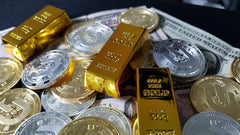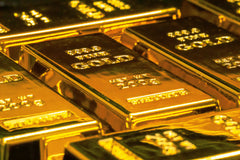Cryptocurrency vs Precious Metals - Correlations, Tokenisation & Flows
There’s been a growing interest in cryptocurrency in the last few years. However, the volatility of crypto and its potential as a store of value are often questioned, especially when compared to the tried-and-true safe-haven status of precious metals.
Looking ahead, it’s essential than ever to understand how these two assets will compete or complement each other.
This article will break down the differences between cryptocurrency and precious metals. We will also analyse the key factors affecting both markets, helping you make informed investment choices.
TL;DR
|
Factor |
Cryptocurrency |
Precious metals |
|
Market behaviour |
Highly volatile with rapid price fluctuation |
More stable, tends to retain value over time. |
|
Supply & demand |
Limited supply driven by demand for digital assets. |
Limited by mining and environmental factors. |
|
Liquidity |
Highly liquid with 24/7 trading across global exchanges. |
Liquid, but trading hours depend on the market and exchanges. |
|
Ownership |
Digital ownership (via wallets or exchanges). |
Physical ownership (bullion, coins, etc.). |
|
Regularisation |
Mostly unregulated or in the early stages of regulation (varies by country). |
Heavily regulated, especially in terms of trading and mining. |
|
Storage & security |
It requires digital storage and is vulnerable to cyber attacks (hacks, scams). |
Physical storage is required (vaults, safes), secure but costly. |
|
Environmental impact |
Energy-intensive mining, especially for proof-of-work coins (e.g., Bitcoin). |
Mining involves environmental risks, but generally has lower energy consumption than crypto mining. |
|
Use cases |
Primarily used for trading, investment, and as a digital store of value. |
Used in investment, industrial applications, jewelry, and as a store of value. |
|
Tokenisation |
Digital tokens can be easily traded or fractionalised. |
Can be tokenised but typically involves more regulation and complexity. |
Before we go further, are you worried about market uncertainty? Invest in gold and silver today with Bullion Hub for a secure, trusted way to protect your wealth from inflation and volatility.
Market Behaviour & Price Correlations
Cryptocurrency and precious metals behave quite differently in the market.
As of the time of creating this article, Bitcoin trades at approximately A$161,940. Ethereum, the second-largest cryptocurrency, trades around A$3,979, with institutional interest driving momentum. Litecoin is also currently priced at A$134.
Other altcoins, such as Cardano and Solana, experience even wider fluctuations due to their smaller market caps and speculative trading.
Bitcoin price chart
These high prices can present significant opportunities but also pose substantial risks for investors.
Precious metals, on the other hand, exhibit more stability. Gold recently reached a record high of A$5,294 per ounce, while silver has surged to A$55.98 per ounce, its highest in 13 years.
Gold price chart
Silver price chart
These metals are often considered safe-haven assets during economic uncertainty, providing a hedge against inflation and currency devaluation.
Let’s examine the price correlation of both assets. Historically, cryptocurrencies and precious metals have had a low correlation. However, recent trends suggest a shift:
-
Bitcoin and Gold: As of June 2025, the gold correlation to Bitcoin is 0.2. This change suggests that both assets fulfill similar roles in investor portfolios.
Bitcoin vs gold correlation
-
Ethereum and Gold: Ethereum has shown a strong correlation with gold, with analysts noting that macroeconomic factors influencing gold also affect Ethereum's price movements.
|
Asset |
Volatility (Annualised% %) |
Price (June 25, 2025) |
|
Gold |
12% |
A$5,294/oz |
|
Silver |
18% |
A$55.98/oz |
|
Platinum |
20% |
A$1,866.57/oz |
|
Bitcoin |
65% |
A$161,940 |
|
Ethereum |
55% |
A$3,979 |
|
Cardano |
80% |
A$0.98 |
|
Solana |
85% |
$222.15 |
Further reading: What Influences the Price of Gold and Silver
Investment Flows
A survey conducted in 2025 revealed that 32% of Australians own cryptocurrency. The figure represents an increase from just under 28% in 2024 and more than double the share of investors from 2019.
Graph of people who own cryptocurrency in Australia
Additionally, as of the first week in June 2025, digital asset investment products experienced $224 million in weekly inflows, bringing year-to-date totals to $11 billion. Ethereum leads with $296.4 million, driven by developments like the Pectra upgrade and leadership changes.
Publicly traded companies are also increasingly adding cryptocurrencies to their balance sheets. MicroStrategy, for instance, holds approximately 582,000 bitcoins as of June 9th, 2025—nearly 3% of the total supply, reflecting a broader trend of corporate adoption.
Precious metals have also attracted substantial investment. In the first quarter of 2025, gold-backed exchange-traded funds (ETFs) saw an inflow of 226.5 metric tons worth $21.1 billion. This was the most significant quarterly inflow since the first quarter of 2022.
Central banks, particularly in emerging markets such as China, Poland, Kazakhstan, and others, have recently increased their gold reserve. This acquisition resulted in net purchases exceeding 1,000 tonnes annually for three consecutive years.
Silver and platinum have outperformed gold in 2025, with silver's returns reaching 26.8% and platinum's increasing by 15% month-to-date. Factors such as industrial demand and supply constraints are responsible for this shift.
|
Asset Class |
Recent Inflows (2025) |
Key Drivers |
|
Bitcoin |
$11 billion YTD |
Institutional adoption, corporate treasuries |
|
Ethereum |
$296.4 million (June) |
Network upgrades, leadership changes |
|
Gold ETFs |
$21.1 billion |
Central bank purchases, geopolitical tensions |
|
Silver |
26.8% YTD return |
Industrial demand, supply deficits |
|
Platinium |
15% month-to-date |
Jewelry demand, industrial applications |
Comparative breakdown of cryptocurrency and precious metals investment flows
Precious metals have proven to be a reliable hedge against financial uncertainty. At Bullion Hub, we offer you the opportunity to confidently invest in gold and silver.
Don’t wait for the next market downturn. Secure your future today by investing in tangible, reliable gold and silver assets.
Tokenisation
Major financial institutions are embracing Ethereum for tokenisation. For instance, BlackRock launched the USD Institutional Digital Liquidity Fund (BUIDL) on Ethereum, providing on-chain access to U.S. Treasury bills and cash equivalents.
Additionally, Visa is piloting its Tokenised Asset Platform (VTAP) on Ethereum to enable banks to issue and manage fiat-backed tokens.
Australia is also actively embracing tokenisation, especially in the crypto space. The Reserve Bank of Australia (RBA) is collaborating on projects like Project Acacia to develop and test wholesale central bank digital currencies (CBDCs) that aim to improve settlement efficiency for tokenised assets.
On the other hand, Australia is witnessing a rise in tokenised precious metals, with the Perth Mint playing a key role. They offer products like PMGOLD, enabling investors to gain gold exposure without requiring physical storage.
Meanwhile, companies like Pallion Group, through ABC Refinery, ensure that tokenised precious metals are backed by verifiable physical assets, meeting global refining and certification standards.
What about the supply chain?
Supply Chain & Refinery Impact
Cryptocurrency mining, particularly Bitcoin, remains highly energy-intensive.
In 2025, Bitcoin mining will consume 97.23 - 175.87 terawatt-hours (TWh) annually, equivalent to the electricity usage of countries such as Argentina or Sweden.
This massive energy consumption can strain local power grids, increasing electricity prices and potential shortages, especially in regions with limited infrastructure.
Additionally, the rapid technological advancements in mining hardware contribute to significant electronic waste. The average Bitcoin transaction generates approximately 272 grams of electronic waste.
Precious metals supply chains rely heavily on physical mining and refining. In 2025, geopolitical and environmental factors will constrain the gold and silver refining capacity. Mining companies invest heavily in exploration and M&A to secure supply amid rising demand.
|
Aspect |
Cryptocurrency mining |
Precious metal mining |
|
Energy consumption |
High (97.23–175.87 TWh/year for Bitcoin) |
Moderate (varies by metal and region) |
|
Electronic waste |
High (272g per transaction) |
Moderate (depends on recycling rates) |
|
Environmental impacts |
High (carbon emissions, grid strain) |
High (deforestation, water contamination) |
|
Geopolitical risk |
Moderate (regulatory changes, energy policies) |
High (resource nationalism, trade restrictions) |
Are Cryptocurrency and Precious Metals in Competition or Complement?
Depending on the investor's perspective and market conditions, cryptocurrency and precious metals are competitors and complements.
Bitcoin’s market cap hit $2.12 trillion in May 2025, surpassing silver’s $1.89 trillion for the first time but still far behind gold’s $22.26 trillion.
Despite their complementary roles, Bitcoin and gold exhibit differing market behaviors. In early 2025, gold prices surged to historic highs, driven by investor demand amid economic uncertainties, while Bitcoin experienced volatility, reflecting its higher risk profile.
Additionally, the correlation between Bitcoin and gold has fluctuated. As of late March 2025, gold had risen 16%, while Bitcoin had fallen by more than 6%, indicating a decoupling of their price movements.
In 2025, cryptocurrency and precious metals will not merely compete but will be complementary assets. Investors recognise the value of diversifying portfolios by investing in both gold's stability and Bitcoin's growth potential.
For instance, a Reddit user asked whether to invest in gold or crypto.
Someone replied,
Looking Ahead to 2025 and Beyond
Analysts project the cryptocurrency total market capitalisation to reach $8 trillion by March 2026. The Standard Chartered (STAN) also shared in a research report that the market cap will reach $10 trillion by the end of 2026.
As of June 16th, 2025, Bitcoin is trading at A$162,572.38. Financial institutions specialised in crypto predict a rise to A$308,290 by the end of 2025.
Precious metals, particularly gold and silver, will remain safe-haven assets.
Litefinanace forecasts that gold prices will reach A$5,099.53 - A$6,086.53 per ounce by the fourth quarter of 2025, potentially exceeding A$6,088.58 per ounce by mid-2026. Also, analysts forecast silver prices to increase by 7% in 2025 and an additional 3% in 2026 due to high industrial demand and limited supply growth.
Further reading: Gold Price Prediction 2025: Trends, Forecast, & Key Factors
Silver Price Prediction 2025: Trends, Forecast, & Key Factors
Key Takeaway
Ryan Best, founder of STBL, said in his LinkedIn post.
“It’s not precious metals or crypto—it’s both.
Combining the stability of gold and silver with the liquidity and transparency of crypto is the future.
Why reap the rewards from one asset class when you can capitalise on both?”
Do you want to start your precious metal investment adventure to preserve your wealth and diversify your portfolio?


